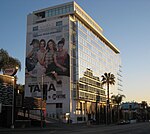Hacienda Arms Apartments

Hacienda Arms Apartments, also known as Coronet Apartments and Piazza del Sol, is a historic building located on the Sunset Strip in West Hollywood, California. The four-story, 52,000-square-foot (4,800 m2) Italian Renaissance Revival sourced Mediterranean Revival style structure was built in 1927 and operated initially as a luxury apartment building catering to the entertainment business. In the 1930s, it became the "most famous brothel in California." The building declined in prestige in the 1950s and 1960 and was acquired by rock star Rod Stewart in the 1970s. After Stewart's plans to redevelop the building as a luxury hotel ended in a legal dispute, the building was nearly destroyed in a 1983 fire that was found to be of suspicious origin. It was extensively renovated and, since 1986, has been known as the Piazza del Sol. It now houses the offices of several production companies, including Miramax Films. The restaurant Katana, co-owned by Ryan Seacrest and Tori Spelling and described by Newsweek as "so hip it hurts," also operates at the building.
Excerpt from the Wikipedia article Hacienda Arms Apartments (License: CC BY-SA 3.0, Authors, Images).Hacienda Arms Apartments
West Sunset Boulevard,
Geographical coordinates (GPS) Address Nearby Places Show on map
Geographical coordinates (GPS)
| Latitude | Longitude |
|---|---|
| N 34.095 ° | E -118.37333333333 ° |
Address
West Sunset Boulevard 8418
90069
California, United States
Open on Google Maps








